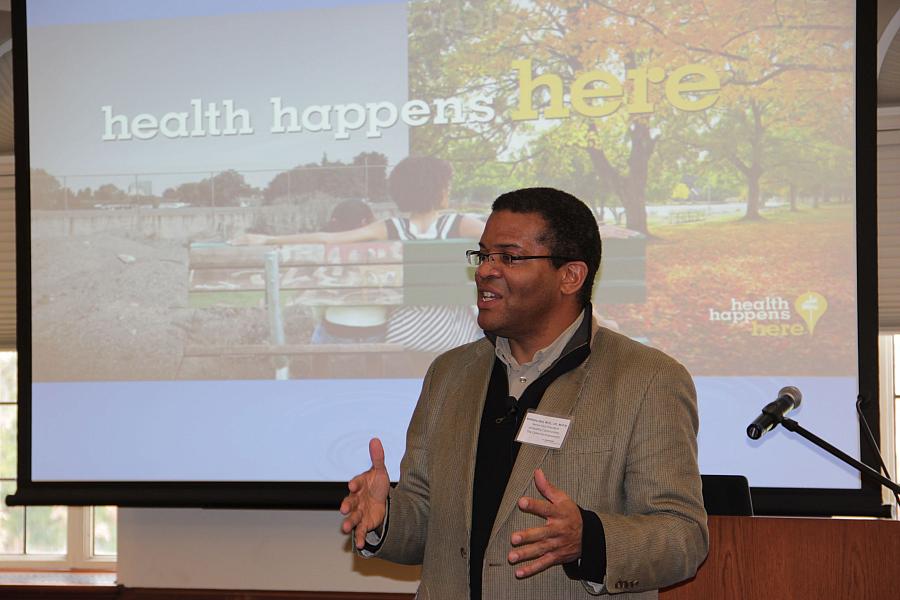Why ‘Health Doesn’t Equal Health Care’

Dr. Anthony Iton
Growing up in the comparative idyll of Montreal, Dr. Anthony Iton still remembers the shock of first arriving in Baltimore, where he’d enrolled in medical school at Johns Hopkins University, just as the crack epidemic was unfurling in the mid 1980s.
After seeing the apocalyptic streets and destitute residents of the neighborhood abutting the hospital, Iton recalls asking a companion: “When was there a war here?” The abandonment and human suffering seemed unimaginable to someone who’d grown up with steady lifts from the Canadian safety net. In contrast, “You go to East Baltimore, you’ve seen Calcutta,” he said. “You’ve seen one of the worst slums in North America.”
His time in Baltimore instilled in him the abiding sense that when it comes to health, place matters deeply. “What would my health have been if I’d grown up there rather than Montreal, Canada?” he said, speaking to reporters at this week’s California Health Journalism Fellowship. (Dr. Iton is a senior vice president at The California Endowment, a funder of the Fellowship and Reporting on Health.)
That budding appreciation for how geography and its correlates — race, class, access to healthy food, parks and good schools, and so on — impacts health would later inspire his pioneering work in Alameda County, where, as director of the county public health department, he analyzed 400,000 death certificates from over 50 years by Census tracts to reveal staggering differences in lifespans between neighborhoods just a few miles apart.
With the data clearly showing pockets of premature death in the poorest Zip codes, Iton suddenly had a stark map of the county’s health disparities to show hitherto skeptics. He recalls his Harvard-trained epidemiologist “running down the hall with the map, saying, ‘You’re not going to believe this!’ And I was like, ‘I think I will.’”
The pattern has since been replicated in communities throughout the U.S. Take the low-income neighborhood of Hough in Cleveland, Ohio, for instance, where the average life expectancy is 64 years. Seven miles away in upper-middle class Lyndhurst, the average jumps to just over 88 years. That strong connection between neighborhood and life expectancy shapes Iton’s characteristic catchphrases: “Tell me your Zip code, and I’ll tell you how long you’ll live,” and, “Does your Zip code matter more than your genetic code?”
But this growing recognition that “social determinants” and place ultimately matter more than health care doesn’t necessarily translate into enlightened health journalism. Health reporters tend to focus on the workings of the health care system itself, and in so doing, often omit the larger picture of the forces shaping health, according to Iton.
“Health care is what happens when things go wrong,” he said. “Health care doesn’t actually make you healthy — it prevents you from deteriorating rapidly.”
By way of analogy, he says the health care system is a bit like firefighters rushing to put out the very same fire every day. After awhile, it makes sense to look at what’s actually causing the fires rather than just reacting once the predictable emergency is under way. Likewise, chronic diseases aren’t going away, but Iton isn’t alone in thinking our only chance of controlling their disproportionate impact on poor people is by tackling the larger social and environmental forces driving them.
But doing so will require journalism that can convincingly depict those same forces. “Health stories are almost always told in portrait, not in landscape,” Iton said. (One ambitious exception he pointed to is the award-winning series "Shortened Lives: Where You Live Matters," by Suzanne Bohan and Sandy Kleffman.)
For journalists, it’s easy to hear Iton’s talk and walk away feeling overwhelmed at the complexity and magnitude of the social, economic and environmental factors sculpting any community’s health. But his framework also suggests that there’s plenty of room for smaller stories as well, stories that deliberately tease out the health implications of planning board decisions, walkable neighborhoods and pocket park proposals. Said Iton:
One of my other conclusions it that health is political – small ‘p’ political. When I say political, we’re talking about: How do you get a park built in your neighborhood so your kids have a safe place to play, how do get a grocery store in your community so you can get fresh produce. Believe it or not, those things are controlled in a political process. And so if you don’t participate in that process, the likelihood you’ll get the park or grocery store is substantially diminished.
In that sense, the health stories that matter aren’t just about enrollment figures and premium hikes. They’re also the bread-and-butter stories of local politics, but as seen through a new lens that helps readers connect the dots between the places they live and their collective prospects for living longer, healthier lives.

